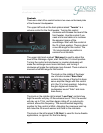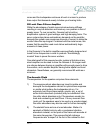
ver 1.0
16
1616
16
~ÄëçäìíÉ=ÑáÇÉäáíó™
small amount of absorption. Hence, a curtained glass window
would just be about perfect.
2. Sidewalls. Because the speaker is a dipole it is less sensitive
to the sidewalls. However, as a rule of thumb, it is a good
idea to keep the speaker as far away from the sidewalls as is
practical. With this in mind, it may be helpful to add some
damping material or diffuser panels to the point of first
reflection. This is a point on the sidewalls between the listener
and the loudspeaker. It is where the sound from the
loudspeaker first hits the sidewall, then bounces to the
listener. This reflection is undesirable because it is slightly
delayed from the original sound and “smears” pinpoint
imaging. This point on the sidewall can be easily determined
with the help of a second person and a mirror.
Sitting in your listening position have an assistant hold a
mirror up on the sidewall. Move the mirror until you can see
the tweeter. This is the point of first reflection. A diffuser (see
your dealer), an absorptive material or even a piece of
furniture (a rack of CDs or LPs is ideal) can help break up this
point of first reflection.
3. Rear wall. In many cases it will be unnecessary to do
anything with the wall behind your listening position unless
you are sitting very close to the rear wall. You may want to
experiment with diffusers or absorbers behind you for best
sound. Absorption behind the listener is usually beneficial.
Mastering the Refinements of the system
Fine tuning an audio system is an art that will take time and
patience. It can be one of the more rewarding learning experiences
you will have in the pursuit of music and its enjoyment.
Keep at it and remember to enjoy your music as you work on
perfecting your set-up. Use as wide a range of music and
performances as you can get a hold of in your set-up. The better your
set-up, the better badly-recorded music will sound. If your system only
sounds great on a very small number of “reference recordings”, then
you will be restricted to enjoying a narrow range of music.
One of the best pieces of advice we can offer is that you take
advantage of the ear's ability to identify similarities and differences in


















